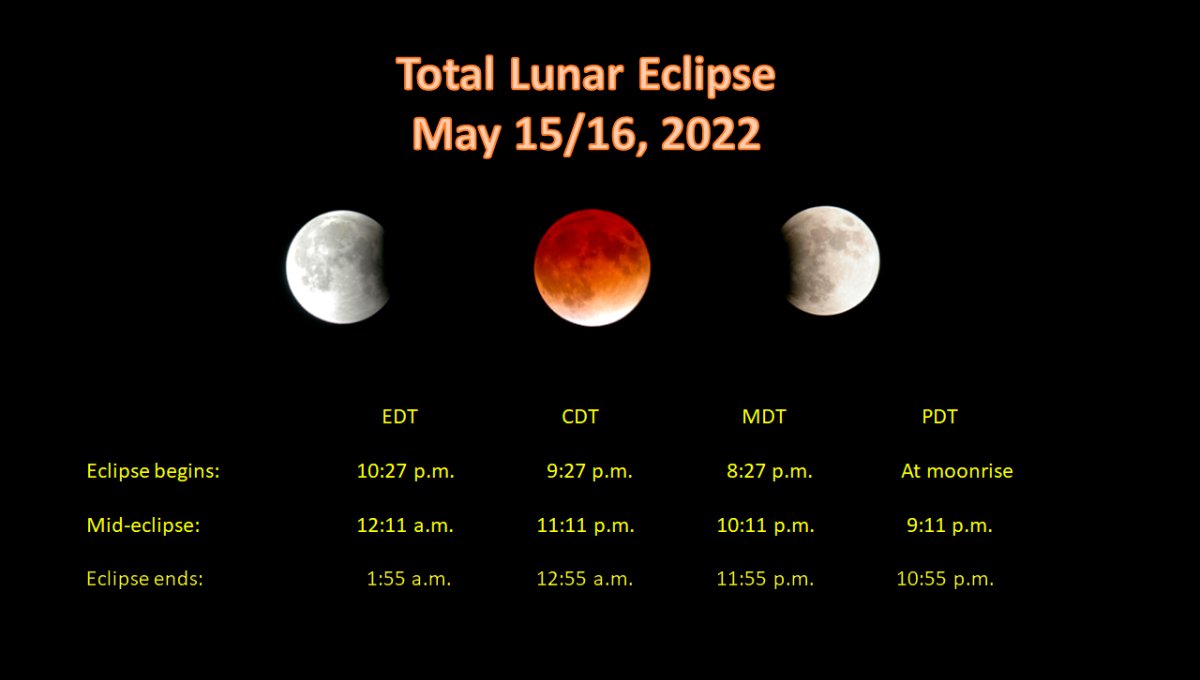A total lunar eclipse is heading Canada’s way in mid-May.

Slated for the night of May 15th, the eclipse should be visible from coast to coast, though, as usual, local weather conditions and time zones will ultimately determine viewing conditions.
The celestial lineup, with the moon in Earth’s shadow, will last around three-and-a-half hours, according to one astronomy educator who lives just outside of Ottawa.
Gary Boyle says Eastern and Central time zones will see the entire eclipse, while Mountain and Pacific time zones will see the eclipse in progress as the moon rises.
“Usually astronomy events happen just when the milkman would deliver milk in the early days, 3 or 4 in the morning, but this is well-timed for North America,” Boyle told Global News.
“Unfortunately for the West Coast, the moon will be eclipsed as it rises at 8:11 p.m.”
A federal government webpage says “unlike solar eclipses, lunar eclipses can be seen by practically an entire hemisphere, which means that a much larger number of people can see them for a longer period of time.”
The moon will be full. And since it’s May, full moons in this month are called flower moons.
One website says full moons in May are also known as corn planting moons and milk moons.

Asked what viewers can expect, Boyle said the moon will be orange-red in colour as it passes through Earth’s shadow.
“And that depends on how much dispersants are in the upper atmosphere,” said Boyle.
“In the 1990s, there was an eclipse in December that disappeared. The Earth’s atmosphere was just clogged with junk. And that’s because the sun refracts through our atmosphere and causes the moon to turn orange, just like we see beautiful red sunsets.”
He added that if you were on the moon during the peak of the eclipse, you would see a beautiful ring of orange around the Earth. Every sunset on the left side and every sunrise on the right.

While not commonplace, lunar eclipses occur two to three times a year. Last year, a total lunar eclipse happened on May 25 (though North Americans only saw part of it), followed by a partial eclipse on Nov. 18 (which was fully visible across North America).
Boyle said that eclipse came close to being a full eclipse and was 97 per cent in Earth’s shadow.
“It wasn’t labelled as a full eclipse, but it was very close,” said Boyle. “But this one will be.”
Later this year, a partial solar eclipse is forecast on Oct. 25, though it won’t be visible in North America. That will be followed by a total lunar eclipse on Nov. 7, with the Pacific and Mountain time zones getting the full show.

Below are the eclipse times for Canada:
Newfoundland Time
- Partial umbral eclipse begins: 11:57 p.m. Moon enters Earth’s shadow.
- Total lunar eclipse begins: 12:59 a.m. Moon turns dark orange or red.
- Greatest eclipse: 1:41 a.m. Mid-point of the eclipse.
- Total lunar eclipse ends: 2:23 a.m. Moon begins to leave Earth’s shadow.
- Partial umbral eclipse ends: 3:25 a.m. Moon completely exits Earth’s shadow.
Atlantic Time
- Partial umbral eclipse begins: 11:27 p.m. Moon enters Earth’s shadow.
- Total lunar eclipse begins: 12:29 a.m. Moon turns dark orange or red.
- Greatest eclipse: 1:11 a.m. Mid-point of the eclipse.
- Total lunar eclipse ends: 1:53 a.m. Moon begins to leave Earth’s shadow.
- Partial umbral eclipse ends: 2:55 a.m. Moon completely exits Earth’s shadow.
Eastern Time
- Partial umbral eclipse begins: 10:27 p.m. Moon enters Earth’s shadow.
- Total lunar eclipse begins: 11:29 p.m. Moon turns dark orange or red.
- Greatest eclipse: 12:11 a.m. Mid-point of the eclipse.
- Total lunar eclipse ends: 12:53 a.m. Moon begins to leave Earth’s shadow.
- Partial umbral eclipse ends: 1:55 a.m. Moon completely exits Earth’s shadow.
Central Time
- Partial umbral eclipse begins: 9:27 p.m. Moon enters Earth’s shadow.
- Total lunar eclipse begins: 10:29 p.m. Moon turns dark orange or red.
- Greatest eclipse: 11:11 p.m. Mid-point of the eclipse.
- Total lunar eclipse ends: 11:53 p.m. Moon begins to leave Earth’s shadow.
- Partial umbral eclipse ends: 12:55 a.m. Moon exits Earth’s shadow.
Mountain Time
- Partial umbral eclipse begins: 8:27 p.m. Moon enters Earth’s shadow.
- Total lunar eclipse begins: 9:29 p.m. Moon turns dark orange or red.
- Greatest eclipse: 10:11 p.m. Mid-point of the eclipse.
- Total lunar eclipse ends: 10:53 p.m. Moon begins to leave Earth’s shadow.
- Partial umbral eclipse ends: 11:55 p.m. Moon exits Earth’s shadow.
Pacific Time
- Partial umbral eclipse begins: 7:27 p.m. Moon will rise as the eclipse begins.
- Total lunar eclipse begins: 8:29 p.m. Moon turns dark orange or red.
- Greatest eclipse: 9:11 p.m. Mid-point of the eclipse.
- Total lunar eclipse ends: 9:53 p.m. Moon begins to leave Earth’s shadow.
- Partial umbral eclipse ends: 10:55 p.m. Moon exits Earth’s shadow.
Boyle said lunar eclipses are safe to watch. And telescopes aren’t needed since it’s a full moon turning orange.
“It’s really something for people to get out and enjoy,” said Boyle. “It’s nature in motion. (The sun, Earth and moon) are lined up. It’s a great event. It’s a great thing for the family to really enjoy.”






Comments